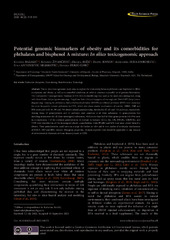Приказ основних података о документу
Potential genomic biomarkers of obesity and its comorbidities for phthalates and bisphenol A mixture: In silico toxicogenomic approach
| dc.creator | Baralić, Katarina | |
| dc.creator | Živančević, Katarina | |
| dc.creator | Božić, Dragica | |
| dc.creator | Jennen, Danyel | |
| dc.creator | Buha-Đorđević, Aleksandra | |
| dc.creator | Antonijević-Miljaković, Evica | |
| dc.creator | Đukić-Ćosić, Danijela | |
| dc.date.accessioned | 2022-01-26T13:51:51Z | |
| dc.date.available | 2022-01-26T13:51:51Z | |
| dc.date.issued | 2022 | |
| dc.identifier.issn | 0327-9545 | |
| dc.identifier.uri | https://farfar.pharmacy.bg.ac.rs/handle/123456789/4026 | |
| dc.description.abstract | This in silico toxicogenomic study aims to explore the relationship between phthalates and bisphenol A (BPA) co-exposure and obesity, as well as its comorbid conditions, in order to construct a possible set of genomic biomarkers. The Comparative Toxicogenomics Database (CTD; http://ctd.mdibl.org) was used as the main data mining tool, along with GeneMania (https://genemania.org), ToppGene Suite (https://toppgene.cchmc.org) and DisGeNET (http://www. disgenet.org). Among the phthalates, bis(2-ethylhexyl) phthalate (DEHP) and dibutyl phthalate (DBP) were chosen as the most frequently curated phthalates in CTD, which also share similar mechanisms of toxicity. DEHP, DBP and BPA interacted with 84, 90 and 194 obesity-related genes/proteins, involved in 67, 65 and 116 pathways, respectively. Among these, 53 genes/proteins and 42 pathways were common to all three substances. 31 genes/proteins had matching interactions for all three investigated substances, while more than half of these genes/proteins (56.49%) were in co-expression. 7 of the common genes/proteins (6 relevant to humans: CCL2, IL6, LPL, PPARG, SERPINE1, and TNF) were identified in all the investigated obesity comorbidities, while PPARG and LPL were most closely linked to obesity. These genes/proteins could serve as a target for further in vitro and in vivo studies of molecular mechanisms of DEHP, DBP and BPA mixture obesogenic properties. Analysis reported here should be applicable to any mixture of environmental chemicals and any disease present in CTD. | |
| dc.publisher | Tech Science Press | |
| dc.relation | info:eu-repo/grantAgreement/MESTD/inst-2020/200161/RS// | |
| dc.rights | openAccess | |
| dc.rights.uri | https://creativecommons.org/licenses/by/4.0/ | |
| dc.source | Biocell | |
| dc.subject | Endocrine disruptors | |
| dc.subject | Bioinformatics | |
| dc.subject | Data mining | |
| dc.subject | Toxicology | |
| dc.title | Potential genomic biomarkers of obesity and its comorbidities for phthalates and bisphenol A mixture: In silico toxicogenomic approach | |
| dc.type | article | |
| dc.rights.license | BY | |
| dc.citation.volume | 46 | |
| dc.citation.issue | 2 | |
| dc.citation.spage | 519 | |
| dc.citation.epage | 533 | |
| dc.citation.rank | M23 | |
| dc.identifier.wos | 000710185900008 | |
| dc.identifier.doi | 10.32604/biocell.2022.018271 | |
| dc.identifier.scopus | 2-s2.0-85122861485 | |
| dc.identifier.fulltext | http://farfar.pharmacy.bg.ac.rs/bitstream/id/9389/Potential_genomic_biomarkers_pub_2022.pdf | |
| dc.type.version | publishedVersion |

